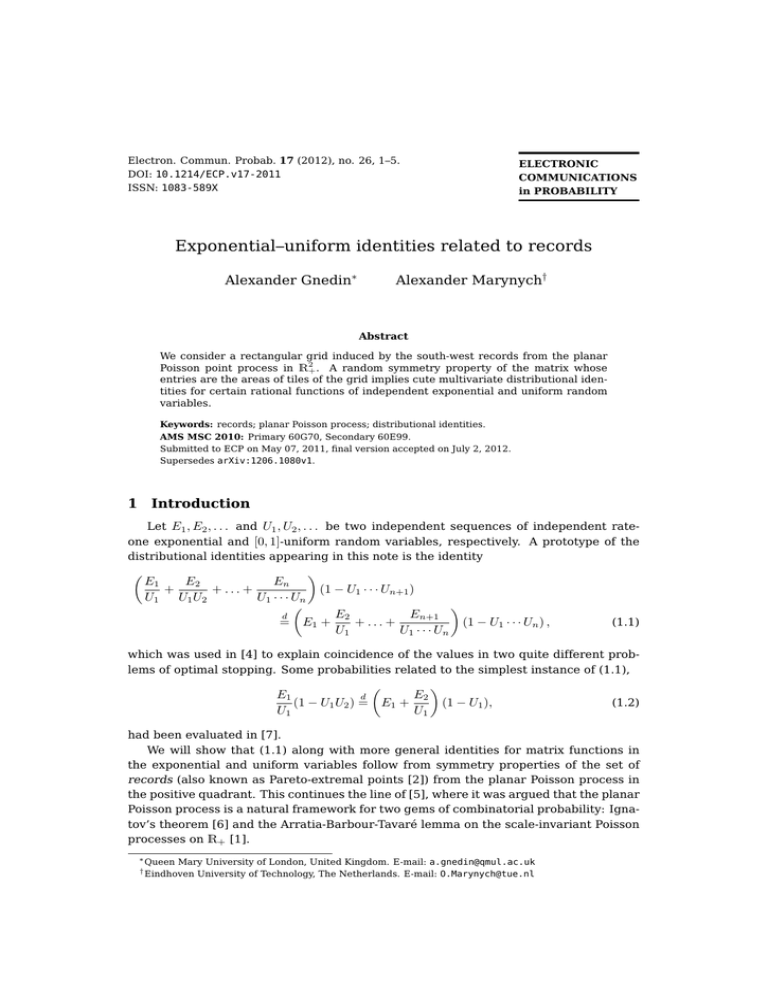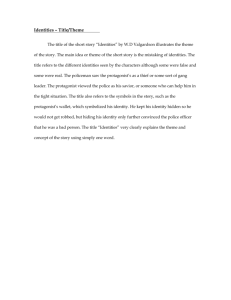Exponential–uniform identities related to records Alexander Gnedin Alexander Marynych
advertisement

Electron. Commun. Probab. 17 (2012), no. 26, 1–5.
DOI: 10.1214/ECP.v17-2011
ISSN: 1083-589X
ELECTRONIC
COMMUNICATIONS
in PROBABILITY
Exponential–uniform identities related to records
Alexander Gnedin∗
Alexander Marynych†
Abstract
We consider a rectangular grid induced by the south-west records from the planar
Poisson point process in R2+ . A random symmetry property of the matrix whose
entries are the areas of tiles of the grid implies cute multivariate distributional identities for certain rational functions of independent exponential and uniform random
variables.
Keywords: records; planar Poisson process; distributional identities.
AMS MSC 2010: Primary 60G70, Secondary 60E99.
Submitted to ECP on May 07, 2011, final version accepted on July 2, 2012.
Supersedes arXiv:1206.1080v1.
1
Introduction
Let E1 , E2 , . . . and U1 , U2 , . . . be two independent sequences of independent rateone exponential and [0, 1]-uniform random variables, respectively. A prototype of the
distributional identities appearing in this note is the identity
E1
E2
En
+
+ ... +
(1 − U1 · · · Un+1 )
U1
U1 U2
U1 · · · Un
E2
En+1
d
= E1 +
+ ... +
(1 − U1 · · · Un ) ,
U1
U1 · · · Un
(1.1)
which was used in [4] to explain coincidence of the values in two quite different problems of optimal stopping. Some probabilities related to the simplest instance of (1.1),
E1
d
(1 − U1 U2 ) =
U1
E2
E1 +
(1 − U1 ),
U1
(1.2)
had been evaluated in [7].
We will show that (1.1) along with more general identities for matrix functions in
the exponential and uniform variables follow from symmetry properties of the set of
records (also known as Pareto-extremal points [2]) from the planar Poisson process in
the positive quadrant. This continues the line of [5], where it was argued that the planar
Poisson process is a natural framework for two gems of combinatorial probability: Ignatov’s theorem [6] and the Arratia-Barbour-Tavaré lemma on the scale-invariant Poisson
processes on R+ [1].
∗ Queen Mary University of London, United Kingdom. E-mail: a.gnedin@qmul.ac.uk
† Eindhoven University of Technology, The Netherlands. E-mail: O.Marynych@tue.nl
Exponential–uniform identities related to records
x
r-3
C-3,-1
C-3,-3
r-2
C-3,-2
C-2,-3
C-2,-1
C-2,-2
r-1
C-1,-1
C-1,-2
C-1,-3
r0
r1
C1,3
C1,1 C1,2
r2
C2,1
C2,3
C2,2
r3
C3,1
C3,2
C3,3
r4
t
Figure 1: The rectangular tiling and areas with the same distribution.
We shall evaluate the areas of tiles for a rectangular grid induced by the set of
records. The identities obtained in this way are genuinely multivariate, albeit they stem
from the arrays with identical marginal distributions. In particular, (1.2) appears by a
row summation in
(1 − U1 )E1
2
(1 − U1 ) E
U1
U1 (1 − U2 )E1
2
(1 − U2 )E2
d
=
(1 − U2 )E2
2
(1 − U1 ) E
U1
.
U1 (1 − U2 )E1
(1.3)
(1 − U1 )E1
A random tiling induced by records
We use the self-explaining notations %, &, ., - for four coordinate-wise partial
orders on the positive quadrant. For instance, relations a % b and b . a for a, b ∈ R2+
both mean that b is located strictly north-east of a.
Let P be the planar Poisson point process with unit intensity in R2+ . It will be convenient to understand P as a random set, rather than counting measure. The event
(t, x) ∈ P is interpreted as the value x observed at time t. Note that with probability
one no two atoms of P lie on the same vertical or horizontal line. An atom r ∈ P is
said to be a (lower) record if there is no earlier observation with a smaller value, that
is a % r for no a ∈ P . The set of records, denoted henceforth R, is a point process with
the intensity function e−tx . The collection of records ordered by increase of the time
component is a two-sided infinite &-chain
. . . & r−2 & r−1 & r0 & r1 & r2 & . . . ,
which we label by nonzero integers in such a way that the records r0 and r1 are separated by the bisectrix t = x.
Drawing vertical lines at t-locations of records (record times), and drawing horizontal lines at their x-locations (record values) divides the positive quadrant into rectangular tiles. Let Cij be the area of the tile whose north-west corner is the intersection
point of the horizontal line through ri and the vertical line through rj (see Figure 1). In
particular, Cii for i ∈ Z is the area of a tile spanned on records ri , ri+1 .
ECP 17 (2012), paper 26.
ecp.ejpecp.org
Page 2/5
Exponential–uniform identities related to records
Given a record at location (t, x), the next record is just the next point of P south-west
of (t, x), hence distributed like (t+E/x, xU ), as is easily seen from the independence and
homogeneity properties of P . The sequence r1 , r2 , . . . is Markovian with just described
transitions, whence
d
(Cij ; i, j = 1, 2, . . .) =
Ej
U1 · · · Ui−1 (1 − Ui )
; i, j = 1, 2, . . . .
U1 · · · Uj−1
(2.1)
Note that the left-hand side of (2.1) is independent of r1 . Since the law of R is not
changed by reflection about the bisectrix, we also have
d
(Ci,j ; i, j = 1, 2, . . .) = (C−j−1,−i−1 ; i, j = 1, 2, . . .).
(2.2)
As an illustration, the areas of two rectangles (Figure 1) spanned on r1 , r4 and r−3 , r0 ,
respectively, have the same distributions.
For n ∈ N and k ∈ Z let Mk,n = (Ck+i−1,k+j−1 , i, j = 1, . . . , n) be the n × n matrix
associated with records rk , rk+1 , . . . , rk+n . Obviously from the above, Mk,n is independ
dent of rk and satisfies Mk,n = M1,n for k = 1, 2, . . . . For k ≤ 0, Mk,n is not independent
of rk , since the transition probability from rk = (t, x) to rk+1 accounts for the condition
d
that −k records must lie south-east of (t, x) above the bisectrix. Also, Mk,n = M1,n fails
for −n < k ≤ 0: for instance, C0,0 and C1,1 have different distributions. Nevertheless,
d
we will show that Mk,n = M1,n holds for k ≤ −n, which by virtue of (2.2) is equivalent
to the following random symmetry property of M1,n .
?
Let M1,n
be the matrix obtained by reflecting M1,n about the antidiagonal, that is by
exchanging each entry (i, j) with entry (n − j + 1, n − i + 1).
Proposition 2.1. For n = 1, 2, . . .
d
?
M1,n
= M1,n .
(2.3)
Identity (1.3) is the n = 2 instance of (2.3). Identity (1.1) appears by calculating the
sum of all entries of M1,n+1 except the entries in the (n + 1)st row. Further identities
can be derived by applying functions, e.g., taking the product of matrix elements in the
first row of M1,n :
E1 · · · En (1 − U1 )n d Enn (1 − U1 ) · · · (1 − Un )
=
.
n−1
U1n−1 U2n−2 · · · Un−1
U1 U22 · · · Un−1
3
Records in a finite box
To prove (2.3) we consider records in finite rectangles. Let A ⊂ R2+ be a finite open
rectangle with sides parallel to the coordinate axes. Atom a ∈ P ∩ A will be called
A-record if no other atom b ∈ P ∩ A lies south-west of a. The set of A-records induces
a random partition of A in rectangular tiles. Denote by N = (Ni,j ) the random matrix
of areas of the tiles. The number of rows (or columns) of N is a random variable that is
∗
one plus the number of A-records. Let N ? = (Ni,j
) be the array obtained by reflecting
N about the antidiagonal, which is defined conditionally on the number of A-records.
Lemma 3.1. For every rectangle A we have
d
(i) N = N ? ,
d
(ii) also N = N ? conditionally given the number of A-records is n, for each n ≥ 0,
(iii) the distribution of N depends on A only through the area of A.
ECP 17 (2012), paper 26.
ecp.ejpecp.org
Page 3/5
Exponential–uniform identities related to records
N1,1
N2,1
N3,1
N1,2
N2,2
N3,2
N1,3
*
N1,1
*
N1,2
*
N1,3
*
N2,1
*
N2,2
*
N2,3
*
N3,1
*
N3,2
*
N3,3
N2,3
N3,3
Figure 2: Records in a square
Proof. Applying a hyperbolic shift (t, x) 7→ (λt, x/λ) with some λ > 0, rectangle A can be
mapped onto a square. The mapping preserves the area and the coordinate-wise orders,
hence preserves the distribution of N . For A a square (i) and (ii) follow by symmetry of
A about the north-east diagonal (see Figure 2).
Lemma 3.2. For n ≥ 1 the following conditional distributions coincide:
(a) the distribution of Mk,n given the area v of the rectangle spanned on records rk
and rn+k , where k ≥ 1 or k ≤ −n − 1,
(b) the distribution of N for a rectangle A of area v , given that the number of Arecords is n − 1.
Proof. For any fixed rectangle A, the set of A-records is independent of the Poisson
point process outside A. On the other hand, given that the north-west and the southeast corners of A are records, P has no atoms south-east of these corners, hence the
set of A-records coincides with R ∩ A. That is to say, given that two records are located
at the corners of A, the records inside A are distributed like A-records. In the same
way, taking, for instance, k = 1, we have: given that r1 and rn+1 are at the corners of
rectangle A (below the line x = t), the set {r2 , . . . , rn } has the same distribution as the
set of A-atoms, conditioned on the event that the number of A-records is n − 1. Now the
assertion follows from Lemma 3.1 (iii).
Proving Proposition 2.1 is now easy. Combining Lemma 3.2 with Lemma 3.1 (ii) we
see that the distributional identity (2.3) holds conditionally on the area of the rectangle
spanned on r1 and rn+1 , hence (2.3) also holds unconditionally. Note that the area is
equal to the sum of all entries of the n × n matrix, that is distributed like
E2
E3
En
(1 − U1 · · · Un ) E1 +
+
+ ··· +
U1
U1 U2
U1 · · · Un−1
.
We could not find a proof of (1.1) by computing densities or transforms, or by connecting to other known identities like “beta-gamma algebra” [3]. Spanning a grid on
the point process of k -corners [5] we were able to show that similar identities hold with
uniform distribution replaced by beta(1, θ).
ECP 17 (2012), paper 26.
ecp.ejpecp.org
Page 4/5
Exponential–uniform identities related to records
References
[1] Arratia, R., Barbour, A. and Tavaré, S.: A tale of three couplings: Poisson- Dirichlet and GEM
approximations for random permutations. Combin. Probab. Comput. 15, (2006), 31–62. MR2195574
[2] Baryshnikov, Yu. M.: Supporting-points processes and some of their applications. Probab.
Theory Related Fields 117, (2000), 163–182. MR-1771659
[3] Dufresne, D.: Algebraic properties of beta and gamma distributions, and applications. Adv.
in Appl. Math. 20, (1998), 285–299. MR-1618423
[4] Gnedin, A.: Best choice from the planar Poisson process. Stochastic Process. Appl. 111,
(2004), 317–354. MR-2056541
[5] Gnedin, A.: Corners and records of the Poisson process in the quadrant. Electron. Commun.
Probab. 13, (2008), 187–193. MR-2399280
[6] Goldie, C. M. and Rogers, L. C. G.: The k -records are i.i.d. Z. Wahrsch. Verw. Gebiete 67,
(1984), 197–211. MR-0758073
[7] Samuels, S.M.: Why do these quite different best-choice problems have the same solutions?
Adv. in Appl. Probab. 36, (2004), 398–416. MR-2058142
ECP 17 (2012), paper 26.
ecp.ejpecp.org
Page 5/5







